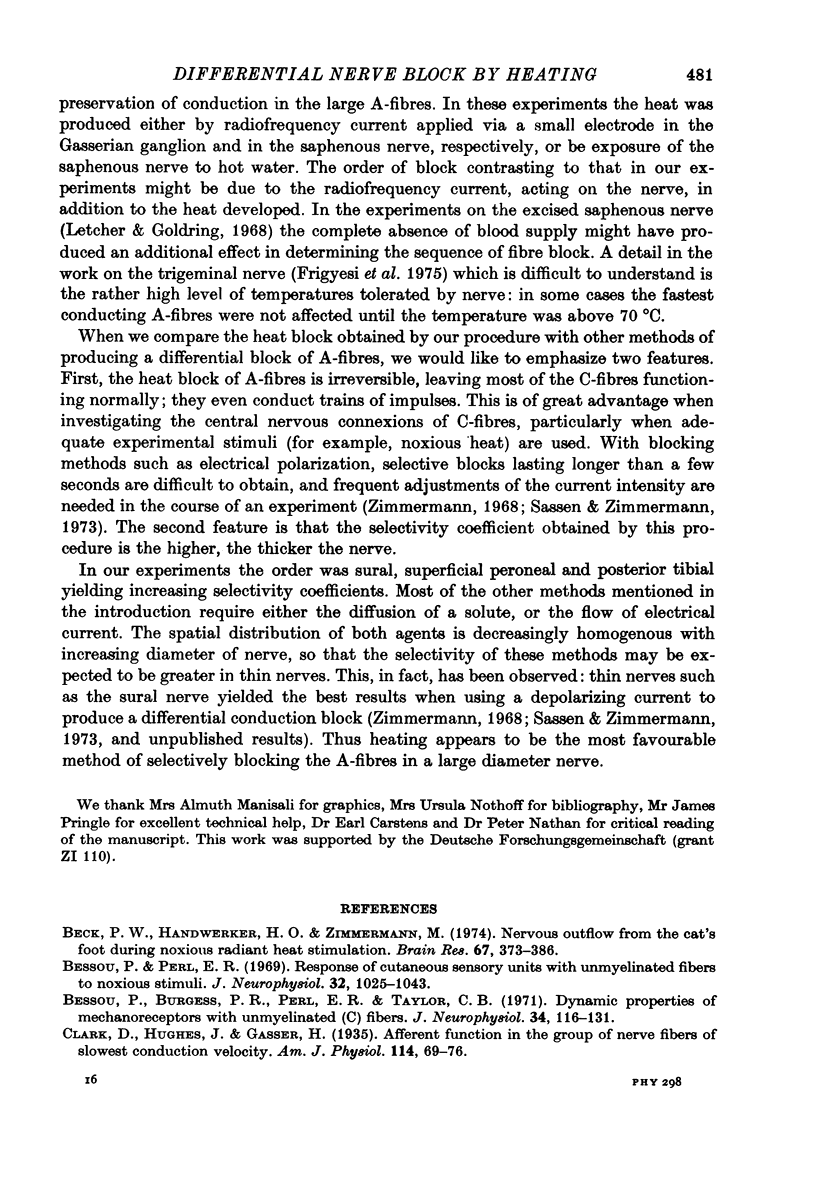Abstract
1. Local heating of a nerve was used to block conduction in the myelinated or A-fibres while preserving normal function in most of the non-myelinated or C-fibres. Compound action potentials of A- and C-fibres, and impulses in single C-fibres were recorded to measure the block. 2. Most experiments were done on the posterior tibial nerve of the cat's hind limb. Conducted heat was applied in successive periods of about 2 min each to 15 mm of the exposed nerve. 3. The range of temperatures used was between 45 and 52 degrees C. Below 46 degrees C no conduction block was obtained. With increasing temperature the cumulative time of heating required to produce a block in at least 99% of A-fibres decreased from around 110 min at 46.5 degrees C to 10 min at 51 degrees C. 4. In the posterior tibial nerve the C-fibre compound action potential was reduced to 0.66 of control (mean of twenty-two experiments) when the A-fibre action potential was less than 1% of control. The corresponding value of this selectivity coefficient was 0.20 in seven superficial peroneal and sural nerves. 5. Once a conduction block of A-fibres was reached the remaining C-fibres showed normal functioning, including conduction of repetitive impulses at up to 30 Hz evoked by electrical nerve and adequate skin stimulation. C-fibre conduction persisted for at least 33 h, but not longer than 3 days. 6. This pure C-fibre nerve might be useful for studying central nervous system effects of C-fibres.
Full text
PDF











Selected References
These references are in PubMed. This may not be the complete list of references from this article.
- Beck P. W., Handwerker H. O., Zimmermann M. Nervous outflow from the cat's foot during noxious radiant heat stimulation. Brain Res. 1974 Mar 8;67(3):373–386. doi: 10.1016/0006-8993(74)90488-0. [DOI] [PubMed] [Google Scholar]
- Bessou P., Burgess P. R., Perl E. R., Taylor C. B. Dynamic properties of mechanoreceptors with unmyelinated (C) fibers. J Neurophysiol. 1971 Jan;34(1):116–131. doi: 10.1152/jn.1971.34.1.116. [DOI] [PubMed] [Google Scholar]
- Bessou P., Perl E. R. Response of cutaneous sensory units with unmyelinated fibers to noxious stimuli. J Neurophysiol. 1969 Nov;32(6):1025–1043. doi: 10.1152/jn.1969.32.6.1025. [DOI] [PubMed] [Google Scholar]
- DOUGLAS W. W., MALCOLM J. L. The effect of localized cooling on conduction in cat nerves. J Physiol. 1955 Oct 28;130(1):53–71. doi: 10.1113/jphysiol.1955.sp005392. [DOI] [PMC free article] [PubMed] [Google Scholar]
- Franz D. N., Iggo A. Conduction failure in myelinated and non-myelinated axons at low temperatures. J Physiol. 1968 Dec;199(2):319–345. doi: 10.1113/jphysiol.1968.sp008656. [DOI] [PMC free article] [PubMed] [Google Scholar]
- Frigyesi T. L., Siegfried J., Broggi G. The selective vulnerability of evoked potentials in the trigeminal sensory root of graded thermocoagulation. Exp Neurol. 1975 Oct;49(1 Pt 1):11–21. doi: 10.1016/0014-4886(75)90192-2. [DOI] [PubMed] [Google Scholar]
- Fukushima K., Yahara O., Kato M. Differential blocking of motor fibers by direct current. Pflugers Arch. 1975 Jul 28;358(3):235–242. doi: 10.1007/BF00587220. [DOI] [PubMed] [Google Scholar]
- Heavner J. E., de Jong R. H. Lidocaine blocking concentrations for B- and C-nerve fibers. Anesthesiology. 1974 Mar;40(3):228–233. doi: 10.1097/00000542-197403000-00004. [DOI] [PubMed] [Google Scholar]
- IGGO A. Cutaneous mechanoreceptors with afferent C fibres. J Physiol. 1960 Jul;152:337–353. doi: 10.1113/jphysiol.1960.sp006491. [DOI] [PMC free article] [PubMed] [Google Scholar]
- IGGO A., WALSH E. G. Selective block of small fibres in the spinal roots by phenol. Brain. 1960 Dec;83:701–708. doi: 10.1093/brain/83.4.701. [DOI] [PubMed] [Google Scholar]
- IRIUCHIJIMA J., ZOTTERMAN Y. The specificity of afferent cutaneous C fibres in mammals. Acta Physiol Scand. 1960 Jul 15;49:267–278. doi: 10.1111/j.1748-1716.1960.tb01952.x. [DOI] [PubMed] [Google Scholar]
- Iggo A., Kornhuber H. H. A quantitative study of C-mechanoreceptors in hairy skin of the cat. J Physiol. 1977 Oct;271(2):549–565. doi: 10.1113/jphysiol.1977.sp012014. [DOI] [PMC free article] [PubMed] [Google Scholar]
- Jewett D. L., King J. S. Conduction block of monkey dorsal rootlets by water and hypertonic saline solutions. Exp Neurol. 1971 Oct;33(1):225–237. doi: 10.1016/0014-4886(71)90116-6. [DOI] [PubMed] [Google Scholar]
- Jänig W., Schmidt R. F., Zimmermann M. Single unit responses and the total afferent outflow from the cat's foot pad upon mechanical stimulation. Exp Brain Res. 1968;6(2):100–115. doi: 10.1007/BF00239165. [DOI] [PubMed] [Google Scholar]
- King J. S., Jewett D. L., Sundberg H. R. Differential blockade of cat dorsal root C fibers by various chloride solutions. J Neurosurg. 1972 May;36(5):569–583. doi: 10.3171/jns.1972.36.5.0569. [DOI] [PubMed] [Google Scholar]
- Letcher F. S., Goldring S. The effect of radiofrequency current and heat on peripheral nerve action potential in the cat. J Neurosurg. 1968 Jul;29(1):42–47. doi: 10.3171/jns.1968.29.1.0042. [DOI] [PubMed] [Google Scholar]
- NATHAN P. W., SEARS T. A. Differential nerve block by sodium free and sodium-deficient solutions. J Physiol. 1962 Dec;164:375–394. doi: 10.1113/jphysiol.1962.sp007027. [DOI] [PMC free article] [PubMed] [Google Scholar]
- NATHAN P. W., SEARS T. A. Effects of phenol on nervous conduction. J Physiol. 1960 Mar;150:565–580. doi: 10.1113/jphysiol.1960.sp006405. [DOI] [PMC free article] [PubMed] [Google Scholar]
- NATHAN P. W., SEARS T. A. Some factors concerned in differential nerve block by local anaesthetics. J Physiol. 1961 Aug;157:565–580. doi: 10.1113/jphysiol.1961.sp006743. [DOI] [PMC free article] [PubMed] [Google Scholar]
- Sassen M., Zimmermann M. Differential blocking of myelinated nerve fibres by transient depolarization. Pflugers Arch. 1973 Jul 6;341(3):179–195. doi: 10.1007/BF00592788. [DOI] [PubMed] [Google Scholar]
- Wood K. M. The use of phenol as a neurolytic agent: a review. Pain. 1978 Oct;5(3):205–229. doi: 10.1016/0304-3959(78)90009-X. [DOI] [PubMed] [Google Scholar]
- Zimmermann M. Selective activation of C-fibers. Pflugers Arch Gesamte Physiol Menschen Tiere. 1968;301(4):329–333. doi: 10.1007/BF00362643. [DOI] [PubMed] [Google Scholar]


